
Hover flies, also called flower flies or syrphid flies, make up the insect family Syrphidae. As their common name suggests, they are often seen hovering or nectaring at flowers; the adults of many species feed mainly on nectar and pollen, while the larvae (maggots) eat a wide range of foods. In some species, the larvae are saprotrophs, eating decaying plant and animal matter in the soil or in ponds and streams. In other species, the larvae are insectivores and prey on aphids, thrips, and other plant-sucking insects.

Eristalinae are one of the four subfamilies of the fly family Syrphidae, or hoverflies. A well-known species included in this subfamily is the dronefly, Eristalis tenax.
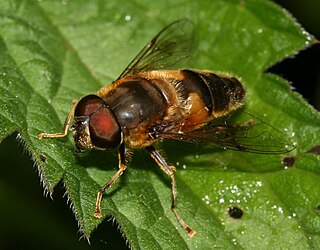
Eristalis pertinax is a European hoverfly. Like Eristalis tenax, the larva of E. pertinax is a rat-tailed maggot and lives in drainage ditches, pools around manure piles, sewage, and similar places containing water with high organic load and low oxygen concentration.

Xylota segnis, The Brown-toed Forest Fly, is a common species of hoverfly.
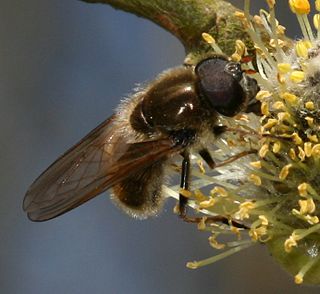
Cheilosia albipila is a European and Palearctic species of hoverfly. Like most Cheilosia it is black, and because of this may often be overlooked as a hoverfly. It is little recorded but probably widespread and common and maybe overlooked because adult flight periods are early in the year, before many hoverfly recorders are active.

Merodon equestris is a Holarctic species of hoverfly. Like many other hoverflies it displays a colouration pattern similar to a stinging insect as an evolutionary defense mechanism. Other syrphid bee mimics are Mallota, Arctophila, Criorhina, Pocota and Brachypalpus. Merodon species are distinguished from these by the very strong hind femora, which bear a large triangular projection on the underside near the tip. It flies in low vegetation while the other bumblebee mimics prefer higher vegetation layers.

Meliscaeva cinctella is a Holarctic species of hoverfly.
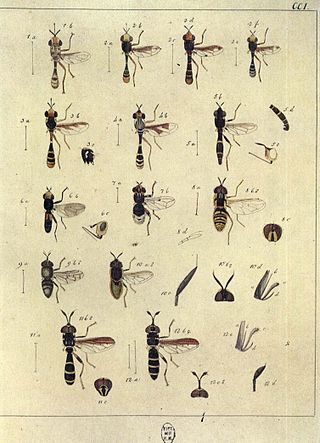
Callicera is a Holarctic genus of hoverflies

Eumerus ornatus is a species of hoverfly, from the family Syrphidae, in the order Diptera.

Microdon mutabilis, is a species of hoverfly. It is found in many parts of Britain and Europe. The distinctive almost slug-like larvae live in ants' nests. They are hemispherical in shape, heavily armoured and believed to prey on the eggs and larvae of a number of ant species, including Formica lemani, Formica fusca, Lasius niger and Myrmica ruginodis. It was described by Carl Linnaeus in his landmark 1758 10th edition of Systema Naturae.

Pipizini is a tribe of small to medium-sized generally black hoverflies, although some species also have orange spots on their abdomen. This nondescript colouring can lead to some species being confused with other dark hoverflies from other tribes. The lack of a facial knob is a good defining feature which separates them from most of these other hoverflies. As with other species in the subfamily Syrphinae the larvae feed on aphids though there seems to be a preference for wax-secreting aphids e.g. Pemphigidae.
Pipiza festiva is a species of hoverfly, from the family Syrphidae, in the order Diptera.

Parasyrphus lineolus is a Holarctic species of hoverfly.

Parasyrphus vittiger is a species of hoverfly, from the family Syrphidae, in the order Diptera.
Parasyrphus malinellus is a species of hoverfly, from the family Syrphidae, in the order Diptera.
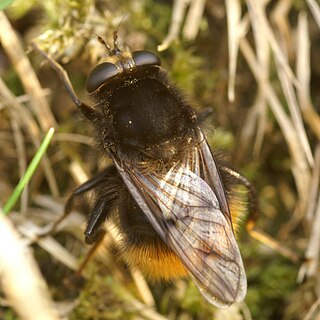
Criorhina ranunculi, is a species of hoverfly found in the spring in many parts of Britain and Europe.
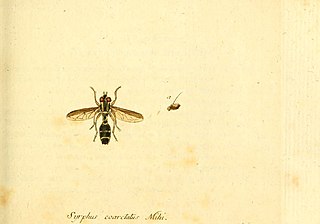
Doros profuges is a Palearctic species of hoverfly.

Eumerus funeralis or lesser bulb fly is a species of Hoverfly, from the family Syrphidae, in the order Diptera. E. funeralis appears in Peck (1988) as a synonym of E. strigatus (Fallen), but was reinstated as the correct name for tuberculatus Rondani, sensu auctorum by Speight et al. (1998).
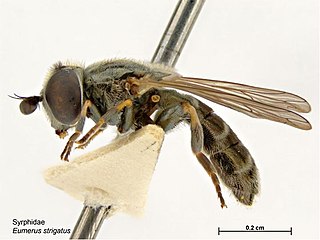
Eumerus strigatus ,, the Onion Bulb Fly , is a fairly common species of syrphid fly observed acoss Europe. Also found in north-central North America and other scattered locations as an introduced species from infested bulbs. Syrphid flies are also known as Hover Flies or Flower Flies because the adults are frequently found hovering around flowers from which they feed on nectar and pollen. The larvae feed on various bulbs. .

















